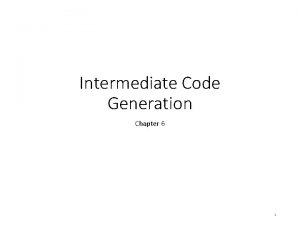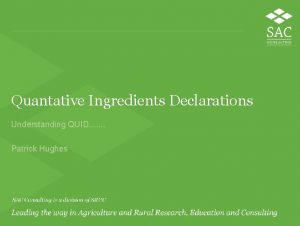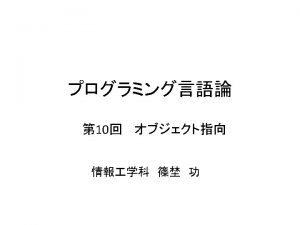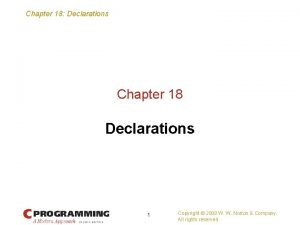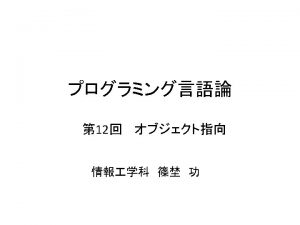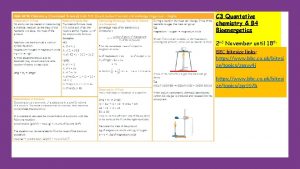Quantative Ingredients Declarations Understanding QUID Patrick Hughes Origins






















- Slides: 22

Quantative Ingredients Declarations Understanding QUID. . . . Patrick Hughes

Origins of QUID • Food Labelling Regulations 1996, as amended by the Food Labelling (Amendment) Regulations 1998 and the Food Labelling (Amendment) (No. 2) Regulations 1999. • They place the similar guidance developed by the European Commission (III/5260 -rev 5/98) in a UK context and should be read in conjunction with regulation 19 of the Food Labelling Regulations 1996, as amended by the Food Labelling (Amendment) Regulations 1998 and the Food Labelling (Amendment) (No. 2) Regulations 1999. • The examples which this presentation contains are provided for illustration only. 2

What is a “QUID” Declaration? • A “QUID” declaration shows the percentage of an ingredient or category of ingredients in a product. • Such a declaration enables a consumer to make a more informed choice from similar products. 3

General Requirement • The quantity of an ingredient or category of ingredients used in the preparation of a food shall be indicated where – – that ingredient or category of ingredients appears in the name of the food or is usually associated with that name by the consumer; – that ingredient or category of ingredients is emphasised on the labelling in words, pictures or graphics; or – that ingredient or category of ingredients is essential to characterise a food and to distinguish it from products with which it might be confused because of its name or appearance. 4

WHEN IS A “QUID” DECLARATION REQUIRED? • A QUID declaration will be required in the following circumstances: • When an ingredient appears in the name of the food, e. g. – pork in a “pork sausage” – peaches in a “peach yoghurt” – mushrooms in a “mushroom pizza” 5

• When the category of ingredients appears in the name of the food. • Categories of ingredients will include cheese, fish, fruit, nuts and vegetables, e. g. – vegetables in a “vegetable pasty” – fish in “fish fingers” – meat in a “meat pie” 6

• When a product is identified by a customary name alone, without further explanation, then a QUID declaration may still be required even though no ingredients have been identified in the name. • A declaration will be required where an ingredient or category of ingredients is usually associated with the food by the consumer – a declaration for “fruit” in “summer pudding” – a declaration for “mutton” in “Lancashire hot pot” 7

• Where the ingredient or category of ingredients is emphasised on the label in words or pictures that ingredients or category of ingredients will require a QUID declaration, e. g. – flashes such as “with extra cream” or “made with real butter” – a picture showing just one or a few ingredients, e. g. the label of a mixed fruit yoghurt only showing strawberries 8

• When the name of a compound ingredient appears in the name of the food then that ingredient will require a QUID declaration. • A compound ingredient is an ingredient which itself is made up of a number of ingredients, e. g. seafood, mayonnaise etc. • If a compound ingredient appears in the name of a food then it will require a QUID declaration, e. g. “seafood lasagne” will require a QUID declaration for the amount of seafood in the product. 9

Example 1 • Many foods now carry percentage declarations as required by the QUID rules. • Example 1 - This is the main panel from a pack of 'Yogurt Coated Nuts and Raisins' • The full legal name is also given as 'Yogurt coated peanuts, almonds, hazelnuts and raisins' 10

• Since the word 'yogurt coating', 'nuts' and 'raisins' appear in the name of the food, the ingredient's list has to declare the percentage of these used. • It was considered unnecessary to declare the percentage of the different types of nuts or the percentage of yogurt: 11

• The following would not require a QUID declaration: – serving suggestion – pictures showing all the ingredients – warnings for allergy sufferers 12

Example 2 • The following is another example. • This is the back panel from a 'Cheese and Tomato Quiche'. • The full legal name of the food is 'Medium mature cheddar cheese, red cheddar cheese, mozzarella and tomato combined with a creamy egg custard encased in a crisp shortcrust pastry'. 13

• The ingredients list therefore has to declare the various ingredients listed in this name. In this case, the percentage of cheese, egg, tomato and cream are given. • In addition, the label also gives the percentage of onion 14

When will a “QUID” Declaration not be required? • A QUID declaration will not be required in the following circumstances: – Where a product in a liquid medium (i. e. water, fruit juice, vinegar, ice, brine etc) shows, both the drained weight and the net weight. – Where the quantities of an ingredient or category of ingredients has already been given under: • The Fruit Juices and Fruit Nectars Regulations 2003 • The Jam and Similar Products Regulations 2003 • The Spreadable Fats (Marketing Standards) Regulations 1996 (as amended) – Where the ingredient or category of ingredients is used in small quantities for the purposes of flavouring (e. g. garlic, herbs or spices). Small quantities are deemed to be 2% or less by weight at the mixing bowl stage. The exemption is not limited to flavourings which are additives. Products covered by this exemption would include: • “Cinnamon Danish” and other products which refer to herbs or spices either specifically or generically in their name 15

When will a “QUID” Declaration not be required? • When an ingredient or category of ingredients appears in the name of the food, but the quantity of the ingredient will not govern the consumer’s choice or distinguish one product from another. This exemption will only apply if the ingredient appears in the name of the food. Cases where this will apply include: • wholemeal bread • single cereal breakfast cereals, e. g. Cornflakes • where the food is a mixture of fruit, vegetables, nuts, spices or herbs with no ingredient dominant significantly by weight 16

Are meat products affected by “QUID”? • Meat products are affected by QUID in the same way as other products. • Therefore any ingredients that appear in the name of the food must bear a QUID declaration, e. g. the percentage of beef in a “beef burger”. 17

How are “QUID” declarations calculated? • The quantity of an ingredient or category of ingredients should generally be expressed as a percentage. The percentage may be rounded to the nearest whole number, or to the nearest 0. 5 decimal place in those cases where it is below 5% • The percentage should normally be calculated by using the same method as that used for determining the order in the list of ingredients • This means that the weight of an ingredient to be quantified* would need to be divided by the total weight of all of the ingoing ingredients (except the weight of any added water or volatile ingredients lost in processing). *for example, the meat content of a “Beef and beer pie”, or the fish content of a “Salmon mousse”, 18

Example 3 • Simply divide the weight of the meat ingredient (at the mixing bowl stage) by the total weight of the product after cooking multiplied by 100. • For example, Beef Pasty Ingredients: Wheat Flour, Potato, Beef, Swede, Water, Margarine, Lard, Onion, Salt, Pepper, (Raising Agent E 503), etc… – – – Weight of pastry Weight of all the non meat ingredients [Potato, Swede etc. ]; Weight of the meat ingredient; Total of weight uncooked Total of weight after cooking [10% loss] 2 kg 5 kg 0. 95 kg 7. 155 kg • Divide (0. 95 kg ÷ 7. 155 kg) x 100 = 13. 27% 19

Example 4 • QUID declarations on products (such as cakes, biscuits, pies and cured meats) the composition of which has been changed by cooking or other treatments involving loss of moisture should be based on the amount of the ingoing ingredient expressed as a percentage of the weight of the final product. For example, the butter content of a “butter cookie” would be calculated as follows: • Ingredients: – – – Flour Sugar Butter Eggs Total mixing bowl Total after baking Weight: 100 g 35 g 50 g 195 g 169 g • Formula: 50/169 x 100 = 29. 6% • Where this calculation would lead to declarations exceeding 100%, the declarations should be replaced with statements giving the amount of the ingredients used to make 100 g/ml of the final product (e. g. “made with Xg/ml of Y per 100 g/ml”) 20

Position of “QUID” declaration • The required indication must accompany the name of the food or be in the list of ingredients. 21

Thank you 22
 What's a qualitative observation
What's a qualitative observation Difference between qualitative and quantitative data
Difference between qualitative and quantitative data Iso 14024 type 1
Iso 14024 type 1 Comparing declarations venn diagram
Comparing declarations venn diagram Comparing declarations venn diagram
Comparing declarations venn diagram Benefits of intermediate code generation
Benefits of intermediate code generation Mark hughes jill hughes
Mark hughes jill hughes Hexameter of boger
Hexameter of boger Dic nobis maria quid vidisti in via
Dic nobis maria quid vidisti in via Declinazione quis quid
Declinazione quis quid Antigona stilske figure
Antigona stilske figure Diagnostische vraagstelling quid
Diagnostische vraagstelling quid Quid pro quo cyber security
Quid pro quo cyber security Quid
Quid Quid
Quid Quid food
Quid food Vir viri declinado
Vir viri declinado Quid scrabble
Quid scrabble Interrogativi
Interrogativi Origins of cricket
Origins of cricket The origins of hospitality and tourism
The origins of hospitality and tourism Thisisis
Thisisis Map of where vikings travelled
Map of where vikings travelled





